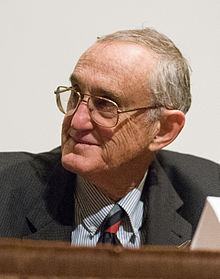David Lee (physicist)
David Morris Lee | |
|---|---|
 David Morris Lee in 2007 | |
| Born | January 20, 1931 |
| Education | Harvard University (BA) University of Connecticut (MA) Yale University (PhD) |
| Spouse | Dana (2 children) |
| Awards | Nobel Prize in Physics (1996) Oliver Buckley Prize (1981) Simon Memorial Prize (1976) Buckley Prize (1970) |
| Scientific career | |
| Fields | Physics |
| Institutions | Cornell University Texas A&M University (2009-present) |
| Doctoral advisor | Henry A. Fairbank |
David Morris Lee (born January 20, 1931) is an American physicist who shared the 1996 Nobel Prize in Physics with Robert C. Richardson and Douglas Osheroff "for their discovery of superfluidity in helium-3."[1] Lee is professor emeritus of physics at Cornell University and distinguished professor of physics at Texas A&M University.[2] [3]
Personal life
[edit]Lee was born and raised in Rye, New York.[4] His parents, Annette (Franks), a teacher, and Marvin Lee, an electrical engineer, were children of Jewish immigrants from England and Lithuania. He graduated from Harvard University in 1952 and then joined the U.S. Army for 22 months. After being discharged from the army, he obtained a master's degree from the University of Connecticut. In 1955 Lee entered the Ph.D. program at Yale University where he worked under Henry A. Fairbank in the low-temperature physics group, doing experimental research on liquid 3He.
After graduating from Yale in 1959, Lee took a job at Cornell University, where he was responsible for setting up the new Laboratory of Atomic and Solid State Physics. Shortly after arriving at Cornell he met his future wife, Dana, then a PhD student in another department; the couple went on to have two sons.
Lee moved his laboratory from Cornell to Texas A&M University on November 16, 2009.[5][6][7]
Work
[edit]The work that led to Lee's Nobel Prize was performed in the early 1970s. Lee, together with Robert C. Richardson and graduate student, Doug Osheroff used a Pomeranchuk cell to investigate the behaviour of 3He at temperatures within a few thousandths of a degree of absolute zero. They discovered unexpected effects in their measurements, which they eventually explained as phase transitions to a superfluid phase of 3He.[8][9] Lee, Richardson and Osheroff were jointly awarded the Nobel Prize in Physics in 1996 for this discovery.
Lee's research also covered a number of other topics in low-temperature physics, particularly relating to liquid, solid and superfluid helium (4He, 3He and mixtures of the two). Particular discoveries include the antiferromagnetic ordering in solid helium-3, nuclear spin waves in spin polarized atomic hydrogen gas with Jack H. Freed, and the tri-critical point on the phase separation curve of liquid 4He-3He, in collaboration with his Cornell colleague John Reppy. His former research group at Cornell currently studies impurity-helium solids.
As well as the Nobel Prize, other prizes won by Lee include the 1976 Sir Francis Simon Memorial Prize of the British Institute of Physics and the 1981 Oliver Buckley Prize of the American Physical Society along with Doug Osheroff and Robert Richardson for their superfluid 3He work. In 1997, Lee received the Golden Plate Award of the American Academy of Achievement.[10]
Lee is a member of the National Academy of Sciences and the American Academy of Arts and Sciences.
Lee is currently teaching physics at Texas A&M University and continuing his (formerly Cornell-based) research program there as well.
Lee is one of the 20 American recipients of the Nobel Prize in Physics to sign a letter addressed to President George W. Bush in May of 2008, urging him to "reverse the damage done to basic science research in the Fiscal Year 2008 Omnibus Appropriations Bill" by requesting additional emergency funding for the Department of Energy’s Office of Science, the National Science Foundation, and the National Institute of Standards and Technology.[11]
See also
[edit]References
[edit]- ^ "The Nobel Prize in Physics 1996". Nobel Foundation. Retrieved 2009-10-04.
- ^ "David Lee | Department of Physics Cornell Arts & Sciences".
- ^ "David Lee - Faculty Member | TAMU Physics & Astronomy". 30 September 2019.
- ^ David Lee on Nobelprize.org including the Nobel Lecture, December 7, 1996 The Extraordinary Phases of Liquid 3He
- ^ http://media.www.thebatt.com/media/storage/paper657/news/2009/10/01/News/Nobel.Prize.Winner.Joins.Am.Faculty-3788924.shtml[permanent dead link]
- ^ "A&M lures Nobel Prize winner: Researcher of cold". 2009-09-29.
- ^ "Nobel Prize Winner to Join Texas A&M Physics Faculty | Texas A&M University, College of Science". Archived from the original on 2010-03-07. Retrieved 2009-10-12.
- ^ Osheroff, DD; RC Richardson; DM Lee (1972-04-03). "Evidence for a New Phase of Solid He3". Physical Review Letters. 28 (14). American Physical Society: 885–888. Bibcode:1972PhRvL..28..885O. doi:10.1103/PhysRevLett.28.885.
- ^ Osheroff, DD; WJ Gully; RC Richardson; DM Lee (1972-10-02). "New Magnetic Phenomena in Liquid He3 below 3mK". Physical Review Letters. 29 (14). American Physical Society: 920–923. Bibcode:1972PhRvL..29..920O. doi:10.1103/PhysRevLett.29.920.
- ^ "Golden Plate Awardees of the American Academy of Achievement". www.achievement.org. American Academy of Achievement.
- ^ "A Letter from America's Physics Nobel Laureates" (PDF).
External links
[edit]- Faculty page at Cornell
- David Lee on Nobelprize.org including the Nobel Lecture, December 7, 1996 The Extraordinary Phases of Liquid 3He
- 1931 births
- Living people
- Nobel laureates in Physics
- American Nobel laureates
- American people of British-Jewish descent
- American people of Lithuanian-Jewish descent
- Jewish American physicists
- Harvard University alumni
- University of Connecticut alumni
- Yale Graduate School of Arts and Sciences alumni
- Cornell University faculty
- Cornell Laboratory of Atomic and Solid State Physics
- 21st-century American physicists
- University of Florida faculty
- People from Rye, New York
- Texas A&M University faculty
- Members of the United States National Academy of Sciences
- Foreign members of the Russian Academy of Sciences
- Oliver E. Buckley Condensed Matter Prize winners
- Scientists from New York (state)
- Fellows of the American Physical Society

